#*meta
Text
Stealth worldbuilding.
Put in your backstory that France sunk into the waves in 1892 and wait until the GM mentions a french character to bring it up
434 notes
·
View notes
Text

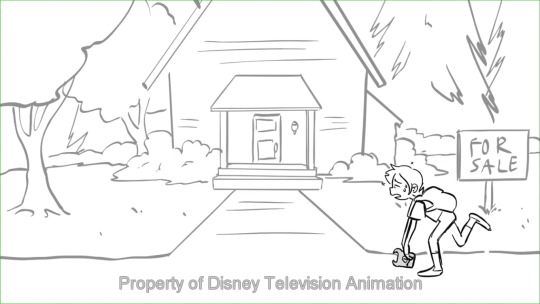
Fascinating to me how in the pilot, Luz found the Boiling Isles because of AMITY... Because she's trying to return this exchange student's passport to her. She chases a bus on foot the entire way just to repay her kindness. And so she follows her through the door.
I think the final version works just as well, considering it emphasizes Luz's connection to Eda and King, as well as her relationship with her mother. But there's also something special about how in the pilot, Luz's pretty obvious crush, and hopes of finding a friend in someone who unwittingly showed her kindness (though she doesn't realize it was unintentional) is what leads her into the Boiling Isles. It's what begins everything, it's what starts her journey and helps her find the place and people where she belongs.
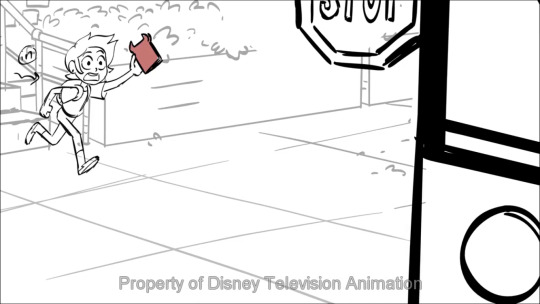
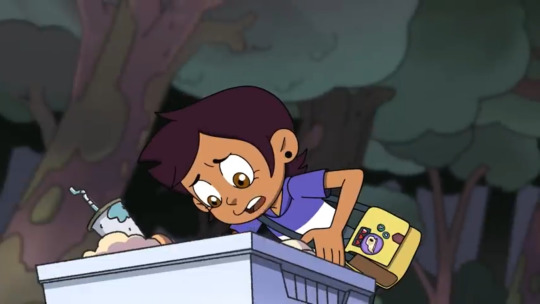
There's just kind of a parallel between Luz trying to return the passport, and Luz wanting to hold onto the book, her father's last gift to her representing their mutual weirdness and kinship with one another. And there would’ve been another Lumity in parallel in them being students of two worlds. The crush vibes are so much more explicit and present from the start, it's like the queer aspect of Luz and the show is intertwined, since the beginning, since the very inciting incident, with the weirdness of our cast and their found family dynamics and everything. Like you can't discuss the weirdness without mentioning the queerness, without acknowledging it as just as much the foundation to the story and Luz.
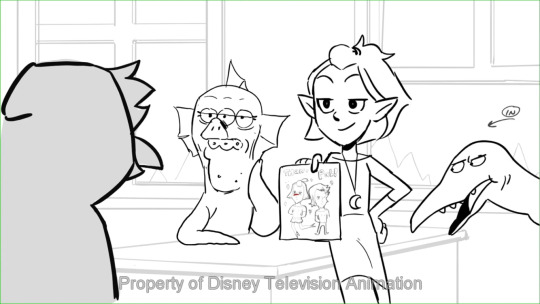
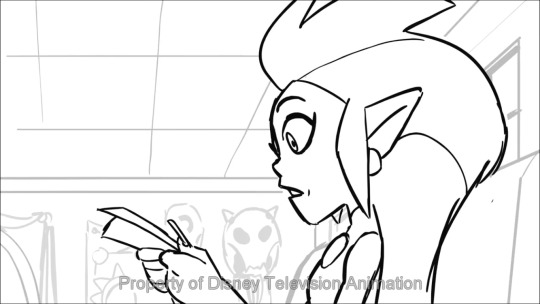
Plus there's Amity rejecting the drawing from Luz, only for it to be appreciated by Eda unknowingly... Once again, someone, unwittingly, is kind to Luz. But in this case Eda is more explicit about encouraging and welcoming Luz, and it makes me wonder if Amity necessarily dismissed the drawing as much, or only did so because she was around her peers? She's much more of a traditional, popular girl prep in the pilot. But then she DOES throw away the drawing, and her seeing Luz later could represent the shift in attitude, her reconsideration.
It's just. You have the mother figure. You have the love interest. And they bring and affirm Luz's ties to the Boiling Isles respectively. Luz doesn't get the approval she was initially looking for, but her quest for it leads her to find approval from someone else; And obviously, her chances with Amity aren't entirely off of the table! Her girlfriend brought her here. She lit up Luz's life in a way, as the final version had Luz barge into Amity's life and light up hers without meaning to.

Plus Eda not being the friend Luz expected or was looking for -they cross paths by pure coincidence- but being the one she truly starts off with in the end. Like how in the final show Luz doesn't quite get what she's looking for, but she finds something else just as great and beautiful. Luz braces herself to be mocked through her drawing by Eda only to be supported and encouraged! All three of these characters are cut from the same cloth, tied together. I love it.
#the owl house#lumity#the owl house pilot#luz noceda#amity blight#eda clawthorne#edalyn clawthorne#analysis#meta
363 notes
·
View notes
Note
Would you participate in a threesome with your parents?
Yes, I've always fantasized about that
Yes, out of curiosity
Yes, but only for cash
Maybe, hehe
No (lying)
NO (I'm boring)
Get help.
293 notes
·
View notes
Text
okay well ACTUALLY i will elaborate on my Whirl feelings. fandom tends to parse 'I want my hands back' as Whirl very specifically being upset he has claws, because they are assumed to be less functional, and broadly that he wants a body which is not empurata'd again. but as I said in this post, we know people who underwent empurata can get new hands and faces- perfectly good ones. tarn used to be damus and damus was a victim of it too, and they got the guy a whole new body! there's no way that with ratchet as autobot CMO, he would not be insistent that they make time and find resources for any empuratee who wants new hands or a new face at SOME point throughout the war. let alone now it's over.
but they would be new ones. the point is that when whirl says 'i want my hands back' he doesn't (just) literally mean 'i want hands again instead of claws', or even 'i want the original hands i was forged with back'. i would argue he means he wants to go back to the person he used to be before the shit he went through beat him into a new shape he hates. (because whirl reeeeally hates himself. we are literally introduced to him during a suicide attempt as his defining character moment, i mean…) but he can't, because that's not possible, and getting new hands won't magically make him the person he was when he was a watchmaker even if it'd make it easier to make watches again.
and that's why whirl doesn't get new hands or a new face! because it's scary to admit that doing so doesn't make him the person he once was again, and if he did it and was still the same damn person, it would be that ultimate proof that nothing he does will ever acheive this. it's safer to remain as he is in a body he hates than to change it and not actually have solved the underlying issue.
it's also why he rejects the offer of ratchet's hands in LL #25. at that point, he has been able to accept the person he now is and will always be going forward, so they no longer carry the same symbolism. sure, that means he could choose to take them without fear, but it also means he can reject them as not really necessary anymore, and i think it makes the most sense for whirl's arc that he chooses the latter, tbh.
(sidenote: especially worth noting we never actually see if whirl can't make watches with his claws. he can at least make clocks! i've seen people suggest you can interpret it as him actually being perfectly capable with his current frame and he doesn't want to admit it and learn a new way because *points at above*, and honestly, intentional reading or not, i fully buy this. i like to imagine post-canon, he's perfectly good at making them with his current hands, because now he's not so hung up on all that baggage that teaching himself the necessary new techniques is unbearable to consider like it was before. this also has the bonus of mitigating some of the comic's uhhh. confusing? messaging around forged/constructed stuff and disability, so i'll take it.)
#i don't talk about whirl as much as some characters but pound for pound#he just is one of the BEST characters in the comic imo#just such a solid throughline that rewards paying close attention to him#idw#whirl#meta
198 notes
·
View notes
Note
How is the Diamond's relationship in this? Are they sisters or more like the typical family structure?
You know, Pink is the daughter, Blue and Yellow the moms and White the grandma
Because if it's the latter then we can say that White Diamond stole her granddaughter's boyfriend and that would be goddamn hilarious
It's funny that this topic keeps coming up. I think back about... 4 years ago? We had a HUGE discussion about this, and now it's back again.
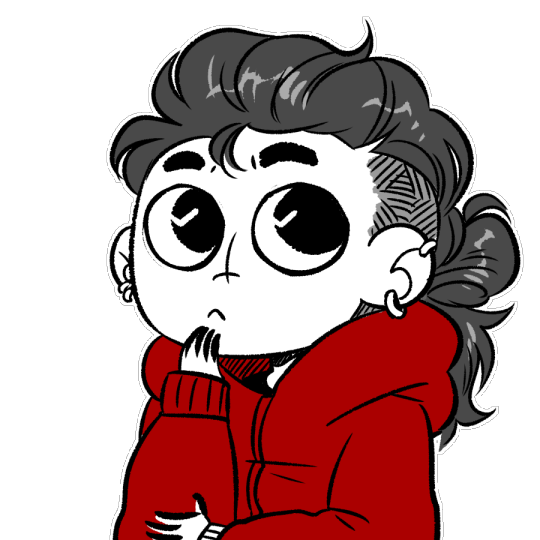
Here's the thing about me, personally:
I dislike trying to put gem-relationships into human-shaped dynamics.
I understand it might be useful for analysis! I understand it might be fun. I understand it's just a way to interpret the text.
But to me, the bottom line is that gems, including diamonds, AREN'T human. That's the fun of it. That's the frosting on top of the worldbuilding cake.
They don't HAVE mother-daughter relationships. Nor sister-relationships. They don't really even have the same romantic relationships as humans do, although I understand that Garnet steers very close. But it's still inherently different because their culture, their history, their very physiology and psychology-are all inhuman!
The Diamonds' family structure is just... that they're all Diamonds. That is their relationship to one another! And yes, that can be compared to either sisters OR mother-daughter-granddaughter, etc. But none of those are really 'truly' the one.
Anyway, sorry. I think that might be overthinking it. But I like to overthink. ¯\_(ツ)_/¯
182 notes
·
View notes
Text
I would also like to say for the record that all of the sects in MDZS are not implied to be any ethnicity but Han Chinese and to be quite frank it is alarming when people try to say the text says otherwise.
Like, this is mildly related to the ask I just answered, and I know we've all seen the meta discussing how barbarianism and racism is (le gasp!) present in Chinese works. (Which, well, yeah. yeah it is.) BUT critically I think in trying to scrutinize and apply shit to MDZS/CQL where all the characters are very much Han, we're just turning up new ways of being racist towards minority ethnicities here.
Case in point: "the Nie are Mongolian"
I've seen this oft repeated everywhere in both meta and fic and...do we understand this??? is racist??? Like the most common justifications I see point to the fact that the Nie (in the live action)....ride horses...have braids in their hair...come from a butcher heritage...are "brutish" <- there's no canonical evidence of this last point btw.
Do we think this is the entirety of what being Mongolian means? Do we think these points add up to "they're subtextually Mongolian?" Why do we think that?
They're not depicted either 1) with Mongolian names 2) with Mongolian religious traditions 3) with Mongolian clothing or hairstyle trends 4) as being reacted to in text as anything other than Han Chinese by other Han Chinese characters. 5) They are depicted on screen by Han Chinese actors.
Like maybe if someone is subscribing to "The Nie are canonically Mongolian and written in a racist way by MXTX in text/depicted in a racist way by the CQL showwriters" they should. Examine what they think being Mongolian is irl.
Maybe the issue is not how sects are presented in CQL or MDZS but how exhausting it is to wade through this fandom where people will misconstrue shit into things that are somehow, more racist in an attempt to deconstruct racism in a system they do not fully understand.
#meta#my meta#it's not even really meta#i'm just so fucking tired of people claiming they're “fixing” racist takes by:#1) creating a racist take out of thin air in a situation that did not originally have a racist take#2) proceeding to somehow get even more racist with it
192 notes
·
View notes
Text
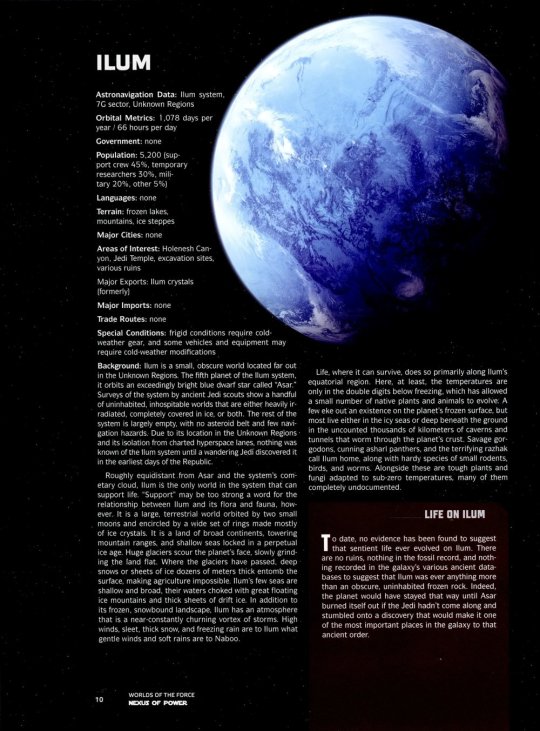
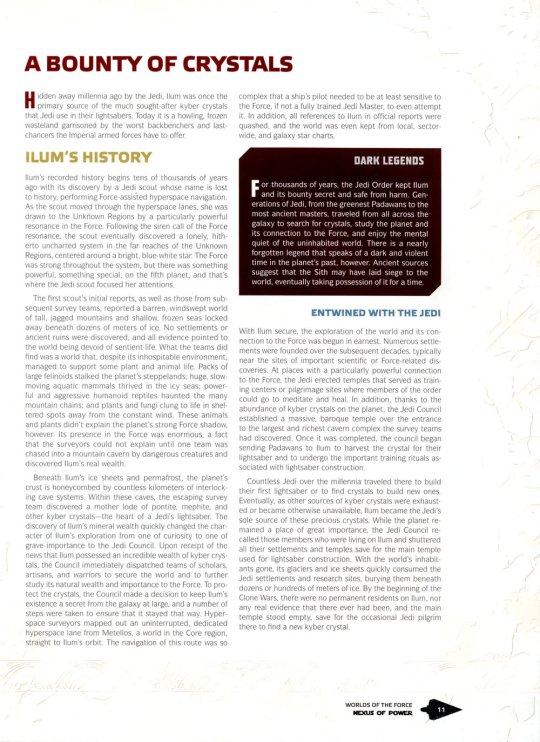
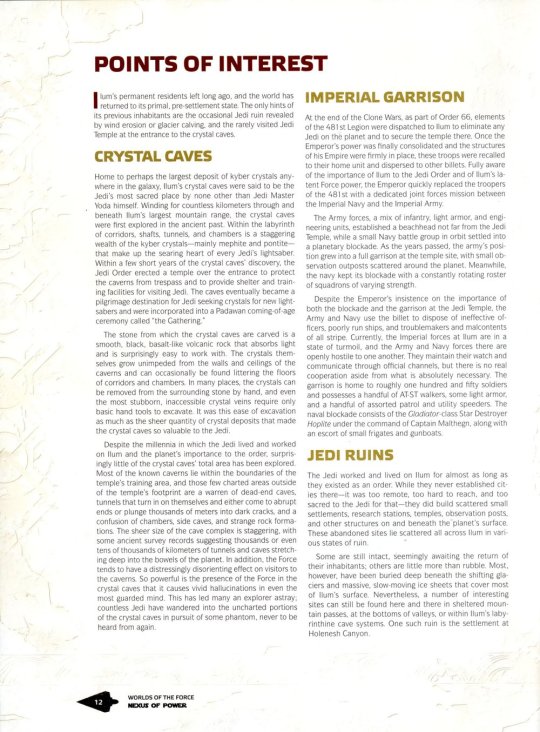



PLANET: ILUM
Astronavigation Data: Ilum system, 7G sector, Unkonwn Regions
Orbital Metrics: 1,078 days per year/66 hours per day
Goverment: None
Population: 5,200 (support crew 45%, temporary researchers 30%, military 20%, other 5%)
Languages: None
Terrain: Frozen lakes, mountains, ice steppes
Major Cities: None
Areas of Interest: Holenesh Canyon, Jedi Temple, excavation sites, various ruins
Major Exports: Ilum crystals
[Source: Star Wars - Force and Destiny - Nexus of Power - Force Worlds]
BACKGROUND:
Ilum is a small, obscure world located far out in the Unknown Regions. The fifth planet of the Ilum system, it orbits an exceedingly bright blue dwarf star called “Asar.” Surveys of the system by ancient Jedi scouts show a handful of uninhabited, inhospitable worlds that are either heavily irradiated, completely covered in ice, or both. The rest of the system is largely empty, with no asteroid belt and few navigation hazards. Due to its location in the Unknown Regions and its isolation from charted hyperspace lanes, nothing was known of the Ilum system until a wandering Jedi discovered it in the earliest days of the Republic.
Roughly equidistant from Asar and the system’s cometary cloud, Ilum is the only world in the system that can support life. “Support” may be too strong a word for the relationship between Ilum and its flora and fauna, however. It is a large, terrestrial world orbited by two small moons and encircled by a wide set of rings made mostly of ice crystals. It is a land of broad continents, towering mountain ranges, and shallow seas locked in a perpetual ice age. Huge glaciers scour the planet’s face, slowly grinding the land flat. Where the glaciers have passed, deep snows or sheets of ice dozens of meters thick entomb the surface, making agriculture impossible. Ilum's few seas are shallow and broad, their waters choked with great floating ice mountains and thick sheets of drift ice. In addition to its frozen, snowbound landscape, Ilum has an atmosphere that is a near-constantly churning vortex of storms. High winds, sleet, thick snow, and freezing rain are to Ilum what gentle winds and soft rains are to Naboo.
Life, where it can survive, does so primarily along Ilum's equatorial region. Here, at least, the temperatures are only in the double digits below freezing, which has allowed a small number of native plants and animals to evolve. A few eke out an existence on the planet’s frozen surface, but most live either in the icy seas or deep beneath the ground in the uncounted thousands of kilometers of caverns and tunnels that worm through the planet’s crust. Savage gorgodons, cunning asharl panthers, and the terrifying razhak call Ilum home, along with hardy species of small rodents, birds, and worms. Alongside these are tough plants and fungi adapted to sub-zero temperatures, many of them completely undocumented.
LIFE ON ILUM:
To date, no evidence has been found to suggest that sentient life ever evolved on Ilum. There are no ruins, nothing in the fossil record, and nothing recorded in the galaxy’s various ancient databases to suggest that Ilum was ever anything more than an obscure, uninhabited frozen rock. Indeed, the planet would have stayed that way until Asar burned itself out if the Jedi hadn’t come along and stumbled onto a discovery that would make it one of the most important places in the galaxy to that ancient order.
ILUM'S HISTORY:
Ilum's recorded history begins tens of thousands of years ago with its discovery by a Jedi scout whose name is lost to history, performing Force-assisted hyperspace navigation. As the scout moved through the hyperspace lanes, she was drawn to the Unknown Regions by a particularly powerful resonance in the Force. Following the siren call of the Force resonance, the scout eventually discovered a lonely, hitherto uncharted system in the far reaches of the Unknown Regions, centered around a bright, blue-white star. The Force was strong throughout the system, but there was something powerful, something special, on the fifth planet, and that's where the Jedi scout focused her attentions.
The first scout's initial reports, as well as those from sub sequent survey teams, reported a barren, windswept world of tall, jagged mountains and shallow, frozen seas locked away beneath dozens of meters of ice. No settlements or ancient ruins were discovered, and all evidence pointed to the world being devoid of sentient life. What the teams did find was a world that, despite its inhospitable environment, managed to support some plant and animal life. Packs of large felinoids stalked the planet's steppelands; huge, slow moving aquatic mammals thrived in the icy seas; powerful and aggressive humanoid reptiles haunted the many mountain chains; and plants and fungi clung to life in sheltered spots away from the constant wind. These animals and plants didn't explain the planet's strong Force shadow, however. Its presence in the Force was enormous, a fact that the surveyors could not explain until one team was chased into a mountain cavern by dangerous creatures and discovered Ilum's real wealth.
Beneath Ilum's ice sheets and permafrost, the planet's crust is honeycombed by countless kilometers of interlocking cave systems. Within these caves, the escaping survey team discovered a motherlode of pontite, mephite, and other kyber crystals—the heart of a Jedi's lightsaber. The discovery of Ilum's mineral wealth quickly changed the char acter of Ilum's exploration from one of curiosity to one of grave importance to the Jedi Council. Upon receipt of the news that Ilum possessed an incredible wealth of kyber crystals, the Council immediately dispatched teams of scholars, artisans, and warriors to secure the world and to further study its natural wealth and importance to the Force. To pro tect the crystals, the Council made a decision to keep Ilum's existence a secret from the galaxy at large, and a number of steps were taken to ensure that it stayed that way. Hyperspace surveyors mapped out an uninterrupted, dedicated hyperspace lane from Metellos, a world in the Core region, straight to Ilum's orbit. The navigation of this route was so complex that a ship’s pilot needed to be at least sensitive to the Force, if not a fully trained Jedi Master, to even attempt it. In addition, all references to Ilum in official reports were quashed, and the world was even kept from local, sector wide, and galaxy star charts.
DARK LEGENDS:
For thousands of years, the Jedi Order kept Ilum and its bounty secret and safe from harm. Generations of Jedi, from the greenest Padawans to the most ancient masters, traveled from all across the galaxy to search for crystals, study the planet and its connection to the Force, and enjoy the mental quiet of the uninhabited world. There is a nearly forgotten legend that speaks of a dark and violent time in the planet’s past, however. Ancient sources suggest that the Sith may have laid siege to the world, eventually taking possession of it for a time.
ENTWINED WITH THE JEDI:
With Ilum secure, the exploration of the world and its connection to the Force was begun in earnest. Numerous settle ments were founded over the subsequent decades, typically near the sites of important scientific or Force-related discoveries. At places with a particularly powerful connection to the Force, the Jedi erected temples that served as training centers or pilgrimage sites where members of the order could go to meditate and heal. In addition, thanks to the abundance of kyber crystals on the planet, the Jedi Council established a massive, baroque temple over the entrance to the largest and richest cavern complex the survey teams had discovered. Once it was completed, the council began sending Padawans to Ilum to harvest the crystal for their lightsaber and to undergo the important training rituals associated with lightsaber construction.
Countless Jedi over the millennia traveled there to build their first lightsaber or to find crystals to build new ones. Eventually, as other sources of kyber crystals were exhaust ed or became otherwise unavailable, Ilum became the Jedi’s sole source of these precious crystals. While the planet remained a place of great importance, the Jedi Council recalled those members who were living on Ilum and shuttered all their settlements and temples save for the main temple used for lightsaber construction. With the world’s inhabitants gone, its glaciers and ice sheets quickly consumed the Jedi settlements and research sites, burying them beneath dozens or hundreds of meters of ice. By the beginning of the Clone Wars, there were no permanent residents on Ilum, nor any real evidence that there ever had been, and the main temple stood empty, save for the occasional Jedi pilgrim there to find a new kyber crystal.
CRYSTAL CAVES:
Home to perhaps the largest deposit of kyber crystals any where in the galaxy, Ilum’s crystal caves were said to be the Jedi’s most sacred place by none other than Jedi Master Yoda himself. Winding for countless kilometers through and beneath Ilum’s largest mountain range, the crystal caves were first explored in the ancient past. Within the labyrinth of corridors, shafts, tunnels, and chambers is a staggering wealth of the kyber crystals—mainly mephite and pontite— that make up the searing heart of every Jedi’s lightsaber. Within a few short years of the crystal caves’ discovery, the Jedi Order erected a temple over the entrance to protect the caverns from trespass and to provide shelter and training facilities for visiting Jedi. The caves eventually became a pilgrimage destination for Jedi seeking crystals for new lightsabers and were incorporated into a Padawan coming-of-age ceremony called “the Gathering.”
The stone from which the crystal caves are carved is a smooth, black, basalt-like volcanic rock that absorbs light and is surprisingly easy to work with. The crystals themselves grow unimpeded from the walls and ceilings of the caverns and can occasionally be found littering the floors of corridors and chambers. In many places, the crystals can be removed from the surrounding stone by hand, and even the most stubborn, inaccessible crystal veins require only basic hand tools to excavate. It was this ease of excavation as much as the sheer quantity of crystal deposits that made the crystal caves so valuable to the Jedi.
Despite the millennia in which the Jedi lived and worked on Ilum and the planet’s importance to the order, surprisingly little of the crystal caves’ total area has been explored. Most of the known caverns lie within the boundaries of the temple’s training area, and those few charted areas outside of the temple’s footprint are a warren of dead-end caves, tunnels that turn in on themselves and either come to abrupt ends or plunge thousands of meters into dark cracks, and a confusion of chambers, side caves, and strange rock formations. The sheer size of the cave complex is staggering, with some ancient survey records suggesting thousands or even tens of thousands of kilometers of tunnels and caves stretching deep into the bowels of the planet. In addition, the Force tends to have a distressingly disorienting effect on visitors to the caverns. So powerful is the presence of the Force in the crystal caves that it causes vivid hallucinations in even the most guarded mind. This has led many an explorer astray; countless Jedi have wandered into the uncharted portions of the crystal caves in pursuit of some phantom, never to be heard from again.
JEDI RUINS:
The Jedi worked and lived on Ilum for almost as long as they existed as an order. While they never established cities there—it was too remote, too hard to reach, and too sacred to the Jedi for that—they did build scattered small settlements, research stations, temples, observation posts, and other structures on and beneath the planet’s surface. These abandoned sites lie scattered all across Ilum in various states of ruin.
Some are still intact, seemingly awaiting the return of their inhabitants; others are little more than rubble. Most, however, have been buried deep beneath the shifting glaciers and massive, slow-moving ice sheets that cover most of Ilum’s surface. Nevertheless, a number of interesting sites can still be found here and there in sheltered mountain passes, at the bottoms of valleys, or within Ilum’s labyrinthine cave systems. One such ruin is the settlement at Holenesh Canyon.
HOLENESH CANYON:
Located some five hundred kilometers from the main Jedi Temple at the mouth of the crystal caves, Holenesh Canyon is a deep, sheer-sided cleft in the planet’s surface over a kilometer deep that runs for roughly ten kilometers through one of Ilum's vast mountain ranges. The settlement, once home to around one hundred sentients, was built near the canyon’s end in the shadow of the mountain range’s highest peaks. It was established millennia ago to study a strange fluctuation in the Force that seemed to occur only once every few hundred years. Named for the Jedi who first recorded the anomaly, this small, isolated outpost stood for centuries before being destroyed in an avalanche triggered by a massive groundquake coinciding with the reappearance of the Force anomaly. Many of the settlement’s inhabitants were killed as they slept, but some managed to escape with little more than the clothes on their backs or what they could grab in their flight. Further seismic disturbances, combined with freak storms, prevented the mounting of a proper rescue mission, and by the time the Jedi were able to return to the canyon, the settlement was completely covered in snow and countless tons of fallen stone.
In the millennia since the destruction of the settlement, parts of it have been exposed through erosion and seismic activity. While the buildings are barely recognizable as such, their contents were surprisingly well preserved. Thanks to the remoteness of the ruined settlement and the difficulty of reaching it, precious little has been removed from the site. Anyone possessing the skills and courage to excavate the site might unearth any number of ancient Jedi relics.
CREATURES AND CHALLENGES:
Ilum's climate is exceptionally harsh. Its land and most of its surface water are locked away beneath glaciers and permanent sheets of ice. Temperatures, even in what are usually considered temperate or tropical zones on other worlds, can sink to dozens of degrees below freezing. These temperatures are typically accompanied by howling gales and blizzards full of driving snow and ice shards. Few creatures, and even fewer plants, live on Ilum. To survive in these brutal conditions, Ilum's creatures and plants are both extremely hardy and extremely dangerous.
ASHARL PANTHER [RIVAL]:
Asharl panthers are one of the more common predators on Ilum. They are large, aggressive, territorial felines that make their homes in Ilum's high northern and southern latitudes. Adult asharl panthers average between two and three meters long and stand roughly one meter high at the shoulder. Their four powerful legs end in two-toed feet equipped with nonretractable claws. The creatures’ bodies are covered in dense, smooth fur in shades of white, gray, and blue that holds their body heat in to protect them from the cold and driving wind. They have broad, earless heads with pronounced brow ridges, and their faces are remark ably expressive, with short, blunt snouts and golden eyes. The most noticeable feature is a pair of long, tentacle-like sensory organs that grow from their shoulders. Asharl panthers live in small family groups and typically hunt in pairs or in groups of four.
BLISMAL [MINION]:
Blismal are small, furry, inoffensive rodents who live in the tunnels and caverns deep beneath Ilum's surface. About the size of a grown human’s hand, blismal have four legs; sharp featured faces with small black eyes, round ears, and long snouts; and short, hairless tails. Their bodies are covered in thick, luxurious, silvery fur that keeps them warm and sheds water and dirt. They feed mostly on cave fungus and insects, and they are happy to be left alone in the dark to live out their lives.
Like the harmless snowfeathers, which live on the surface, blismal have few natural predators. This is largely due to their speed and cautious natures, although they do have a frighteningly effective defense mechanism. When frightened, blismal make a shrill, painful, and sustained shrieking noise to ward off attackers and call for assistance from other blismal. When three or more blismal join in, they create a howl loud enough to shatter crystals and cause cave-ins, an ability that Jedi experienced firsthand long ago. The Jedi attributed this ability to the blismal’s close connection to the Force, and were able to counter the effects of the shrieking by manipulating the Force around the creatures. In doing so, Jedi exploring Ilum's cavern system were able to capture blismal, which turned out to be relatively easy to domesticate.
GORGODON [RIVAL]:
Gorgodons are, perhaps, the most famous creatures to live on frozen Ilum. They are massive, non-sentient, thick-skinned reptilian creatures with long, powerful arms, short legs, and an axe-shaped head. A thick, shaggy coat of dark gray fur covers them from their shoulders to their feet, leaving only their head, which is a sickly orange color, bare to the elements. Gorgodons are incredibly strong and can with stand almost any punishment. It is said that they can even shrug off blaster bolts. They are a dangerous combination of dumb, aggressive, and brutal, and are one of the few animals that attack for no good reason. When the Jedi first arrived on Ilum, the gorgodons were the creatures that gave them the most trouble. Throughout the Jedi Order, the name of this creature was used in threats and curses, such as “thick as a gorgodon” or “as angry as a gorgodon’s mother.”
RAZHAK [NEMESIS]:
Among the most fearsome predators on Ilum, these massive creatures are as agile as they are deadly. Averaging around eight meters in length, razhak-are armored, segmented, wormlike creatures that propel themselves using rippling muscle ridges. Their bodies are broad and flat, covered with thick, chitinous plates in shades of white and blue. While they have no apparent eyes, their heads are topped with long, segmented antennae that serve as sensory organs. Their huge mouths feature multiple rows of serrated teeth.
Aggressive and solitary, razhak live in the endless tunnel systems beneath Ilum's surface. They are deceptively fast and, when they attack, they rear up like a serpent and at tempt to swallow prey whole. Anything they can’t eat in one bite they tear into pieces by grasping it in their mouth and shaking it violently. In addition to possessing great speed and a savage demeanor, razhak also can generate intense heat strong enough to rapidly melt solid ice and cause serious burns to exposed flesh. This ability allows them to tunnel through ice as though it were soft sand. Razhak usually build their nests inside of ice walls or densely packed snow, typically leaving the nest only to eat or mate.
Thankfully, while they are terrifying to behold and extremely dangerous, razhak are also easily distracted and creatures of minimal intelligence. Keeping this in mind, a clever opponent can easily outflank them, lead them into traps, or make them lose interest in attacking altogether.
SNOWFEATHER [MINION]:
Snowfeathers are small, clever, flightless birds native to Ilum. Their bodies are covered in a dense layer of oily, white feathers that protects them from Ilum's bone-chilling cold and vicious weather. Relatively harmless creatures, they live in nesting colonies built into ice shelves or cliff faces.
Despite their inoffensive nature and inability to fly, snowfeathers have few natural predators, for two reasons. First, their meat tastes terrible and is mildly poisonous, causing painful cramps, bloating, and loosening of the bowels in those unfortunate enough to eat them. Second, they have a connection to the Force that gives them the ability to project an illusion that makes them seem larger and more formidable than they really are. These characteristics have allowed them to survive and even thrive on an inhospitable planet full of savage creatures like gorgodons and asharl panthers.
99 notes
·
View notes
Text
** A gentle reminder that you are the algorithm - your reblogs help decide what your followers see, and help them discover the cool things you like.
(I mean like like, not press-like like, which, while appreciated, doesn't have the same impact as a reblog.) **
119 notes
·
View notes
Text
I just realised something about Rouxls Kaard that's... kinda blown my mind a little.
It always struck me as so odd, how confident he was that we wouldn't be able to beat his "puzzles" in Chapter 1. You know, the ones where you push a block one or two spaces onto a switch. He seems so sure that he has thwarted the Fun Gang, and is genuinely flabbergasted when it's solved in a matter of seconds. The whole thing's set up like a joke - haha, look at how stupid this poser looks, thinking he's outsmarted us with such a basic puzzle we've seen thousands of times before. Honestly, I didn't give it much thought afterwards, aside from the odd titter.
But then I learned about the concept of the Magic Circle - the contract entered into by a game and its player(s) that binds them to follow the rules of that game in order to participate, and ultimately win or lose. For this to work, a set of rules need to be agreed upon beforehand, whether that's by the game telling you what they are, the players coming up with their own, or memorising them through repetition and familiarity.
Now, us gamers have seen block-pushing puzzles like these hundreds, if not thousands of times before, so we already know what the premise of RK's puzzle is - push the block onto the switch. We don't even have to think about it for more than one second before we've fully understood the terms of the "game" we've engaged with him, and trounce it with minimal effort.
So guess what we also don't think about? The fact that Rouxls Kaard does not ever explain what the puzzle actually IS, much less what the rules of the puzzle are. And this is why he seems so damn smug about his "Ultimate" puzzles - because he assumes that we don't know what those rules are, and so will flounder around at a complete loss, and at his complete mercy.
(he also doesn't account for trial-and-error, apparently...?)
Now, this establishes something terrifying - Rouxls is under absolutely NO obligation to tell the participants of his puzzles what the rules of those puzzles actually are. And that's fine when you're dealing with something as rudimentary and ubiquitous as a block-pushing puzzle, but scale up the complexity even slightly and this self-aggrandising Duke of Puzzles could very well become an absolute menace. Which makes me a little concerned about his appearances in future chapters.
And if he ends up becoming a secret boss... then God help us all.
119 notes
·
View notes
Text
Things People Seem to Forget About Steve Rogers (aka the past is complex)
Things in the future didn't happen in a vacuum, and while Steve missed a lot of stuff while he was in the ice, he would have seen the roots of things like the Civil Rights, Women's Rights and even LGBTQ+ Rights movements in his time.
While I'm sure Steve encountered a lot of people expecting certain right-wing behaviours from him, due to his birth year and the things he missed in the ice, this doesn't mean he would act that way—even right out of the ice.
But first lets take a look at the things Steve missed and see what he did in fact know:
The atom bomb. Steve never saw the atomic fallout, but what did he see? Hydra bombs literally being flown to his home city. There is also a possibility that as a specialty team, he learned about the German Nuclear Program during the war. His unit was tied to the Strategic Science Reserve, so I wouldn't be surprised if between that, and Hydra's bomb initiatives, Steve was well aware of the potential of a bomb threat. I doubt Steve has clearance to know about the Manhattan project, and I think he would be horrified to learn about the impact of the atom bomb on Japan (especially since he essentially thwarted the same thing from happening to New York) but majorly powerful bombs would not surprise him.
• The Cold War. Steve may not have experience the Cold War, but he grew up surrounded by the outcome of the First World War after the Communist take over of Russia. The debates surrounding Communism, Socialism, and Capitalism aren't new. Steve would have grown up with them and would probably be familiar with American pro-capitalist, anti-communist rhetoric. But would he agree?
Here's some things we know about Steve: He's an artist, he grew up during the Depression which was heavily mitigated by socialist measures, he grew up poor, he grew up disabled. As an artist Steve would be well aware of the debates between the political movements, and with his background, and the success of Roosevelt's New Deal reforms, it would not surprise me if Steve leaned more towards the Socialist side of the scale.
All this to say: Steve would not be unfamiliar with the tension between Russia and the USA. Especially since even though they were allies during the war, there were already concerns that the USSR wasn't so much 'liberating' the countries they drove Germany out of, as putting them under new management.
Steve would be familiar with the tensions underlying the Cold War, and his background might lead him to have a critical view of some of the pro-Capitalist propaganda that came out during the Cold War. While I don't think Steve would approve of Russia's methods and the ultimate outcome of Communism there, I don't think he would approve of the Red Scare Witch Hunt that happened in the States either.
• Civil Rights Movement. While Steve missed the major changes that occurred during the 50s and 60s, he would not be unfamiliar with movements for equality. Steve would also not be unaware of the inequality that minorities faced in his country.
For example:
National Association for the Advancement of Colored People (NAACP) was established in 1909 and is still run today. The NAACP fought and fights against discrimination and advocates for equality.
In the 30s President Roosevelt responded to "to charges that many blacks were the "last hired and first fired," [his administration] instituted changes that enabled people of all races to obtain needed job training and employment. These programs brought public works employment opportunities to African Americans, especially in the North" (Link)
"The first precedent-setting local and state level court cases to desegregate Mexican and African American schooling were decided during [the late 1930s]" (Link)
In 1941 thousands of Black Americans threatened to march on Washington for equal employments rights which pushed Roosevelt to issue an executive order that "opened national defense jobs and other government jobs to all Americans regardless of race, creed, color or national origin." (Link)
The Double Victory or Double V Campaign during the war was an explicit campaign to win the war against fascism in Europe and the war against racism as home.
All this to say, Steve would not be unfamiliar with many of the issues tackled during the Civil Rights Movement of the 50s and 60s.
Not only that, but Steve led a multi-racial special unit during the war during a time of active army segregation. Not only does he have a Black man on his team, but also a Japanese man. This would have most definitely led to backlash from higher command as well as discrimination from other units against Jones and Morita. Steve and the entire Howling Commandos would be explicitly aware of prejudice against two of their members and likely had to fight for them many times.
• Anything space travel. It's true Steve wouldn't know anything about attempts to reach the moon. But there were still several space discoveries he could know about, especially since he and Bucky are clearly interested in scientific discoveries, considering how they went to the Stark Exbo before Bucky shipped out.
Some discoveries:
Hubble's Law: In 1929 Hubble published evidence for an ever expanding universe, and thus provided evidence of the Big Bang theory.
1930: Discovery of Pluto (makes me chuckle to think this is a relatively new discovery for Steve and he wakes up to find it is a dwarf-planet now. You think Millennials are protective of Pluto? I think Steve would be too 😆.)
1937: "the first intimation that most matter in the universe is `dark matter'"
Personally I think Steve would be absolutely amazed by the advances in space travel.
• Women's Rights. Like with Civil Rights, while Steve may have missed the large movements during the 50s and 60s, he was around for the early movements. The 60s movement is called Second Wave Feminism for a reason. This is because there was already many pushes for women equality in Steve's time.
For example:
1920: White women win the right to vote. This means Steve's mother first voted in his lifetime. I feel this alone would make Steve heavily aware of inequality faced by women. (As a side note I feel that Sarah always emphasized voting to Steve since it was such a major development in her lifetime.)
Also in the 20s the Flapper trend rose, along with hemlines. Women's skirts were shorter and they smoked and drank with men. Middle-class and working-class women also worked outside of the home. The 1920s-1930s 'modern' woman is very different from the Victorian vision of a woman in petticoats and skirts.
Early Birth Control movement: Was "initiated by a public health nurse, Margaret Sanger, just as the suffrage drive was nearing its victory. The idea of woman’s right to control her own body, and especially to control her own reproduction and sexuality, added a visionary new dimension to the ideas of women’s emancipation. This movement not only endorsed educating women about existing birth control methods. It also spread the conviction that meaningful freedom for modern women meant they must be able to decide for themselves whether they would become mothers, and when."
1936: A Supreme Court decision declassified birth control information as obscene. Legalised doctor-prescribed contraceptives.
WW2 Watershed: Women serve in the army and work factory jobs. The government establishes universal childcare while women work.
Women also wore pants and form fitting clothes to work in factories. We also see Peggy wearing pants during the last assault on Hydra. While Steve may need to get used to modern fashion, he would already be familiar with the 'morale outrage' over women's clothes in his time, and probably try to manage his surprise in private as well as possible.
• LGBTQ+ Rights. Like with the rest of the equality movements, LGBTQ+ rights movements also started before the late 1900s.
1924: "Society for Human Rights is founded by Henry Gerber in Chicago. The society is the first gay rights organization as well as the oldest documented in America." This organisation was broken up soon after founding due to arrests, but it published "the first American publication for homosexuals, Friendship and Freedom."
In the 1920s and 30s "the gay and lesbian movement started taking shape. Social analysts began rejecting prior medical definitions of "inversion" or "homosexuality" as deviant.
Communities of men and women with same-sex affiliations began to grow in urban areas. Their right to gather in public places such as bars was tenuous, and police raids and harassment were common." (Link)
WW2 Watershed: While many LGBTQ people lived in rural areas or outside 'queer neighbourhoods' the war brought people from all backgrounds together. "As with most young soldiers, many had never left their homes before, and the war provided them an opportunity to find community, camaraderie, and, in some cases, first loves. These new friendships gave gay and lesbian GIs refuge from the hostility that surrounded them and allowed for a distinct subculture to develop within the military."
They still had to hide their identities for fear of persecution and a 'blue discharge', however "Gay and lesbian veterans of World War II became some of the first to fight military discrimination and blue discharges in the years following the war."
It's unclear how much Steve would have known about the gay and lesbian rights movement. But in the comics he has a gay friend Arnie Roth, and there are many meta posts (X X X) about how Steve may have lived in a queer neighbourhood.
And, according to my history professor, gay and lesbian soldiers were often protected by their friends in the army instead of outed. This is not to downplay the discrimination and pain outed veterans faced, but there was a comaraderie and understanding that developed between soldiers that protected many gay soldiers.
• Computer and the internet. The seeds of modern computers began during World War Two. Arguably it began earlier with Ada Lovelace. While technology has changed a lot for Steve, there is a long history of it's development.
Colossus Computer: Kept secret until the 70s, it's unclear if Steve's association with the SSR, Peggy (who was a code breaker before SSR) and Howard, would have led him to know anything about the "the world's first programmable, electronic, digital computer", but we see electric screens and machines being used in Captain America: The First Avenger. So he would know something of those mechanisms.
Also the first American TV was broadcasted in the 1939 World Fair, And since Steve and Bucky are already shown going to a science fair, I believe it is reasonable for Steve to know about the concept of television, though it looks much different in modern day.
• Rise of Neo-Nazis. Steve already saw the rise of fascism in his own country before the war, so while I think he would be horrified and saddened to learn of the Neo-Nazi movement, I don't think he would be surprised.
Because:
Eugenics: A large part of the Nazi campaign, this part of the movement originated and was inspired by the United States Eugenics movement. "It is important to appreciate that within the U.S. and European scientific communities these ideas were not fringe but widely held and taught in universities."
Lobotomies and institutionalisations were part of the treatments for disabled and 'weak-minded' individuals during Steve's time. With Sarah being a nurse it is likely Steve knew of these treatments and more. And as a disabled child of immigrants, I have no doubts Steve brushed up with eugenics beliefs many times.
1939: More than 20,000 people attended a Nazi rally in Madison Square while "[a]bout 100,000 anti-Nazi protesters gathered around the arena in protest".
In the comics Steve canonically has a Jewish friend, Arnie Roth. If he wasn't part of the protests against the Nazi rally, he would have heard about it and known about the rise of antisemitic sentiment in the US before the outbreak of the war.
So Where Does That Leave Us?
Steve has a history of anti-racist behaviour. While he would still have a lot to learn from the Civil Rights Movement and no doubt has unconscious biases he grew up with, he also explicitly builds a multi-racial team that would have led to clashes with systemic racism in the army. This would have inevitably led to him and the Howling Commandos taking an anti-racist stance in protection of their members.
Would Steve say the N-word? Likely not. The N-Word already held negative connotations by the 19th and early-20th century. I doubt Jones would be willing to follow a man who would knowing use the insult. 'Coloured' or 'Negro' were seen as the more acceptable terms. So Steve may use those words at first, instead of 'Black' or 'African-American'. 'Negro' is a controversial term for some Black Americans, so this would be something for him to learn, but he would not purposely by insulting or hurtful. And I believe he would adapt as quickly as possible upon learning.
Steve saw the early steps of many social movements. Given what we know about Steve—artist, disabled, immigrant, poor, raised by a single mom, gay and Jewish friend, potentially lived around queer people, worked with Peggy and smiled when she punched a sexiest, and built a multi-racial team—Steve would not only be aware of the social movements of his time, but he would be happy to learn of the developments after he went into the ice.
While it would take some time for him to learn all the changes that happened, Steve's background would led him to be pleased with the changes in society. This is the opposite of being racist, sexist, and homophobic. Some things might take some adjusting for Steve to get used to, but he is already open-minded and has a frame of reference for many of the social changes that happened.
People sometimes bring up Steve's Catholic upbringing to argue about some beliefs he might have. But while I do think this upbringing would lead to some biases, I think Steve's life experience helped counter, or helped him unlearn some of those biases, even before he hit the ice.
Also, as an Irish-Catholic, Steve would have faced some discrimination of his own. It is most certainly not on the same level as other minorities, and things were better in the 20th century. Being very clear, any discrimination Steve faced for being Irish-Catholic would not be systemic or commonplace like racism. But adding his heritage to the rest of Steve's background helps give us a better idea of why he was already open to social movements like the Civil Rights movement before the ice. And it may have made him already more understanding of LGBTQ+ people, who he may have lived around, even if he grew up being taught certain biases.
Other Things We Forget About Steve
He is quite tech-savvy. While Steve would have a lot to learn, we know he is capable. There are a lot of jokes about his technical know-how in Avengers, but I think he's actually managing very well considering it's probably only been a few weeks or months since he came out of the ice.
Examples:
Deleted scene where we see Steve using a laptop in his apartment. He presses the spacebar to pause a video, which is a keyboard shortcut. So not only can he set up a laptop to watch a video, but he already knows key shortcuts.
Deleted scene where waitress mentions 'wireless'. Steve is confused and thinks she means radio. But I think he actually knows about wi-fi at this point, but probably had never heard it referred to as 'wireless' before. By this point he knows radio is not as common, so his real confusion is why the waitress is offering him 'free radio'. If she had said free wi-fi (the more typical phrase in my opinion) I think he would have understood.
Canon scene of Steve helping Tony fix the Helicarrier engines. This is my favourite evidence because Tony asks Steve to look at the relays and Steve makes a quip that they 'seem to run on some sort of electricity' indicating he is out of his depth. But we never see Tony tell Steve what to do. Steve figures out how to fix the relays himself. Tony is busy with the debris in the rotors and the next thing we see is Steve telling Tony the relays are all good.
Steve is much better at adapting and figuring out technology than we give him credit for. This doesn't mean he won't be anxious or uncomfortable with the sheer amount of stuff he has to learn (especially if everyone keeps making jokes about it to him). But by 2014, it's clear he's already mastered all of it, which is amazing when you think about it, because that's only two years of learning.
Steve is very book smart. In the comics Steve goes to art college, implying he finished high school. Even if he did drop out of high school to work, we know Steve is very smart.
We see him unloading a whole suitcase of books in the barracks before he got the serum.
The mental math is must take to throw the shield at the right angles for it to bounce back is insane.
Steve is also known as a master tactician. So it is clear he has the brains and smarts to run his team during the war. Not only that, but he is not just Captain in name. He actually has that rank, which means he passed the Captain's exam. I also have a feeling he would have needed to pass some kind of evaluation to get the serum in the first place.
We see in Steve's 2014 apartment that his bookshelves are full of history books. Steve is a veracious reader and spends a lot of his time catching up on what he missed. Things he didn't learn or were taught differently growing up would definitely exist, but Steve is actively working to counter that.
Steve would swear. Swearing has been a constant throughout all of history. So too, the backlash against profanity. Even if Steve grew up being told not to swear he would have heard it. And, Steve became a soldier. If he didn't swear before the war, he most definitely picked up some of it then.
I think Captain America isn't supposed to swear, and I think Steve would be aware of this perception of the symbol of him. But I think when Steve is comfortable with people, he would swear. We see in Avengers he doesn't swear, but in Avengers: Age of Ultron, he does.
We joke about Steve and the "Language" line, but I think that line has something to do with Steve's history of being perceived as a symbol and as Captain America since he said it 'just slipped out'. So, while Steve may have been encouraged not to swear growing up, and expected not to swear as Captain America, I fully believe that soldier, veteran, and Irish man Steve Rogers does swear.
Wrap up
I hope you liked this deep dive into Steve's history and character.
I think it can be easy to take the past as a lump sum and view everyone in the past through one lens. We know the past was racist, sexist, and homophobic, so we view everyone from the past that way.
And while it's true things were different back then, people were most definitely fighting for change and aware of the issues. There is also a lot of nuance to the past, and a lot that can be gleaned from what we know about Steve.
It's true that Steve would have a lot to learn when it comes to terminology and specific technology, but I believe Steve's background would prepare him for a lot of the social changes that happened after he went into the ice.
#steve rogers#meta#deep dive#long post#captain america#historically accurate#research#sources cited#early 20th century#20th century history#20th century#social movements#marvel#mcu#please don't tag the other post#no drama please#iykyk#historically accurate steve rogers
95 notes
·
View notes
Text
Dungeon Meshi has fully consumed me, especially a certain tiny union man, and I want to ramble about Chilchuck's traumatic backstory for a bit. Mild manga spoilers under the cut.
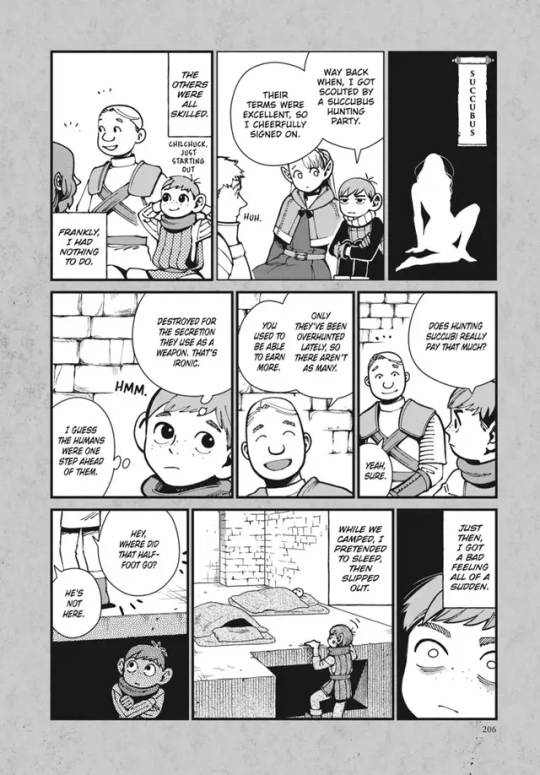

The first time I read the manga I missed this bit, since I was reading an online version that didn't have all the extras included. Since I've come across this litte omake, though, I haven't been able to stop thinking about it. It just explains so much about why Chilchuck is the way he is.
First, at a surface level, it's interesting that this backstory only comes out in the framework of talking about a monster. Chilchuck is offering basically an anecdote about succubi, adding to the conversation he and his party are having about a monster species. It's all very casual and offhand. No one even remarks on what that experience would have meant to Chilchuck on a personal level, and he doesn't dwell on it, either. You have to wonder if Chilchuck would have ever mentioned it at all if they weren't specifically talking about succubi.
But holy heck, just think about this for a moment. On one of Chilchuck's first outings as an adventurer, possibly the first time he joined a party, his fellow adventurers were planning to feed him to a monster. He's only alive now because he had the instinct that something was wrong and had the speed, wisdom, and stealth to run away. He could have died. He could have been murdered. And it's implied that this happens to half-foots frequently in this world.
How traumatizing would that have been for a young adventurer? The people he should have been able to trust to have his back were literally planning his death, all for monetary gain. He was treated as disposable, a resource to be exploited, not a person. Not only is there the trauma of narrowly escaping death here, there's also the trauma of being mistreated and abused by other thinking, intelligent beings.
No freaking wonder he has trust issues. He's been working with Laios and his party for three years at this point and he's never shared a single solitary personal detail about his life, not even his age. He can't bear to allow any vulnerability to show, because he can't allow himself to be taken advantage of again. No wonder he's so prickly and wary. No wonder he's so sensitive to being viewed as anything other than a capable, skilled, fully realized and autonomous adult. No wonder he shies away from affection and any hint of closeness, especially in the early chapters of the manga.
I'm amazed that Chilchuck had the strength and fortitude to stay in the business at all. He considered his options and took steps to keep himself safe, including only accepting pay in advance and starting a union to protect himself and other half-foots. (Another tidbit you don't get at first in the story--Chilchuck is not just a member of a union or the leader, he started the whole dang thing to begin with.)
But what's so lovely, and wonderful, what makes this story take over my brain so completely and utterly, is that Chilchuck doesn't stay this way. Over the course of the manga, he opens up more and more. He allows himself to be emotionally vulnerable; he shares more and more details of his life. He treats Marcille and Izutsumi like daughters, Laios and Senshi like brothers. He loves them and allows himself to be loved in return.
And that's one of many reasons that Dungeon Meshi is one of the best found-family stories I've come across in a long, long time.
114 notes
·
View notes
Text
It feels right that after a year of no Owl House, TOH would give us one final, perfect gift in the form of another universe that captures everything we loved about the original, the beginning of a different yet similar story, one that will never be finished... But the potential, the endless horizons that come from any direction this other story could take, provides the basis for everlasting speculation and discussion and creation. And I think that's beautiful, a final gift encouraging us to take out our pencils and other tools and fill out the blanks and make our own stories with, just as Dana and the crew were inspired to make their own stories by watching other shows and often wanting to fill in the blanks themselves!
182 notes
·
View notes
Text
Let there be light: and how light in Good Omens 2 represents loss and change. Focusing only on Aziraphale for this specific post.

Before the beginning: light already establishes itself as the beginning, but also one of the cataclysmic events through Aziraphale's eyes. It brings about the end; it sets time in motion only to make it stop ticking too. The first being that we see the light on is Aziraphale.
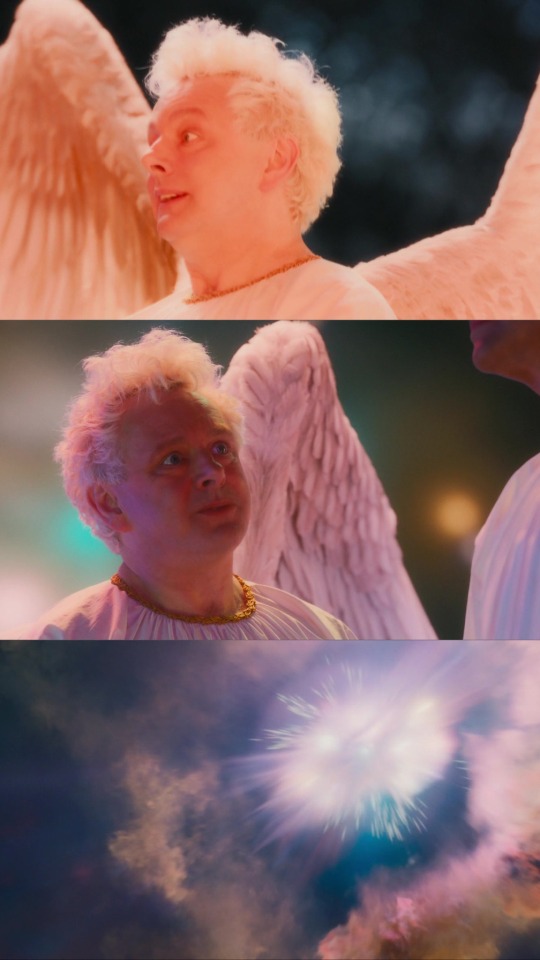
I want to emphasize that lighting is purposely directed and created, especially within the Soho set. Before Aziraphale"loses" his bookshop for the first time, before Jim arrives, he is illuminated from the back. It's peaceful, serene.

Serenity is entangled with the loss of"truth". There's a focus on light the first time we openly see Aziraphale lie to Gabriel.(He had openly lied to God before on the wall of Eden, right under her light).
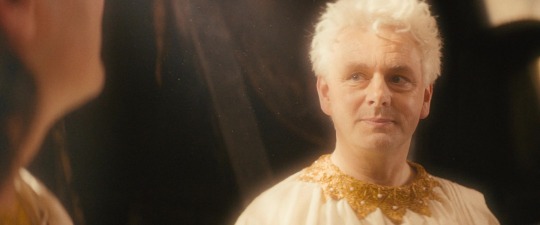
This is the light reflecting Aziraphale's loss again. He has just severed himself partly from the "good". It's lonely, beautiful and complicated.

Light shines partly on him when he realizes the weight that his own morals brought down on Morag and Elspeth. He's gained insight, but at the cost of loss.

Of course very intentionally placing himself on the center stage. Light shining on him to literally focus how life threatening a false move could be. & Candle light at another moment of loss- but loss is not always meant in a negative way.This is the transformation into a less lonely, beautiful terrain of shades of grey.

Light before he loses the bookshop a second time here. But also shining through Crowley's words of not leaving him alone.
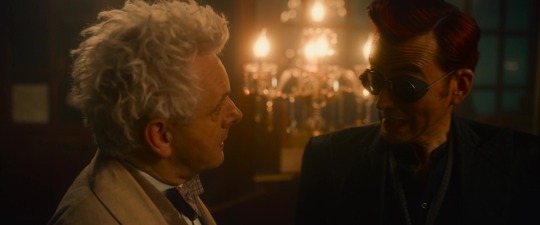
Most poignantly: light before he loses the bookshop a last time. To underline once again how important light is, Gavin Finney pointed this out about this specific scene: The beams of light are purposely directed to where they want them to in the acting area and they wanted it to be glorious for this moment (the kiss) in the bookshop.
"He is about to lose the bookshop so it's important that it looks even more sunny and beautiful".
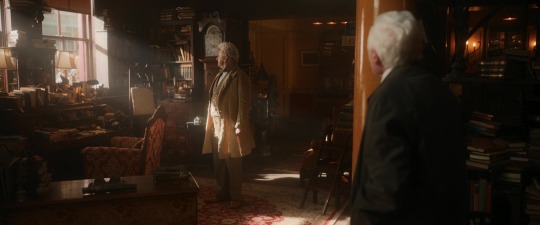
Lastly, the light inside the lift is always there, true, but it's also the last time light illuminates Aziraphale in season 2. Which in this case, might be a precursor for another loss, and definitely indicates another change.

#good omens#crowley#aziraphale#ineffable husbands#neil gaiman#terry pratchett#good omens fun facts#good omens 2#let there be light#meta#gavin finney
74 notes
·
View notes
Text
I’ll go into this in more detail later when I collect some photos, but I think Kabru’s biggest miscalculation is his assumption that Laios doesn’t care about people at all. That he is purely a fan of monsters.
Which simply isn’t the case. I think this is because of what happened to Kabru that he thinks liking humans or monsters are mutually exclusive.
But Laios cares a lot about people. He has a huge heart. He just doesn’t get people.
To his own detriment Laios gives everyone the benefit of the doubt. He’s an optimist who looks for the best in people. He never wants to assume bad intentions.
This is something that Kabru never seems to acknowledge or consider for the most part.
I have specific examples but like I said I want to grab photos first.
80 notes
·
View notes
Text
sorry, still thinking about whirl. imo the most important characteristic whirl has in MTMTE isn't the obvious ones. it's not that he's an asshole, it's not that he's funny, it's not that he's violent, it's not that he's done terrible things, it's not that he hates himself. all of those are important, and they're usually the immediately obvious traits that stick out panel to panel. but they're not what drives the narrative function of the character most across the whole run of the comic.
imo the thing that most defines the engine driving whirl's narrative function is that he is astute and perceptive. it doesn't come up in obviously quotable panels moment to moment, but the way his arc interacts with the overall arc of the comic is that whirl is the one who sees through a lot of the bullshit that's going on and the way he acts and the decisions he makes overwhelmingly rely on that knowledge. unlike most characters, his decisions are rarely defined by the emotional intensity of his own investment in this or that thing (an interpersonal relationship, an insecurity, a need to prove something) but instead by his sharp awareness of the dynamics of the people around him.
whirl knows the score with rodimus and what the whole mess that is their 'mission' is really about- or rather, what it isn't about, not really. he does not take it seriously because he understands in a very real way, it's just not serious, it's an excuse. whirl knows the score with cyclonus and tailgate and when to intervene in that whole mess instead of being kind about it. whirl understands what getaway is doing and where it's leading and that both makes his decision to initially back getaway's plan both an asshole move but also a decision made with total clarity, in contrast to almost everyone else who makes that decision. whirl knows how to get past drift's act and gets a punch in the face for it, because he smells the bullshit there immediately. whirl is not unaware of the social dynamics on the LL at all; he is choosing to be as abrasive and inhospitable as he usually is on purpose with full knowledge of what he's poking at. whirl gets to the supposed afterlife and immediately knows it cannot possibly be real!
unlike basically every other major character, there's really no point whirl makes a decision with his judgement meaningfully clouded by something. he has a strong interiority and motivations, absolutely, but above all else he is making every decision, no matter how bad or self destructive, with a level of genuine awareness and clarity that is pretty much unique, and his assessment of everyone and everything around him is pretty much unmatched if you read between his constant pisstaking. it's fantastically good, and what makes him a completely essential part of the ensemble all the way through the comic's run. nobody else can be so consistently relied on to respond to the situation presented to him as it is. (cyclonus is really the only person in the cast who recognises this, i think, and it explains why they wind up perfectly matched. see again: whirl's interventions with him and tailgate.)
143 notes
·
View notes
Note
How did you come up with the new Steven powers?
Unless they aren’t new, but I thought WD’s power set was just “mind control pew pew” and “reverse mind control pew pew”.
Well, that would be one way to do it. But given that Pink, who we are more familiar with, ended up having a whole SLEW of powers, it makes more sense to me that the powers we see the Diamonds using aren't the only ones they have (the potential for).
And honestly - I just extrapolated.
White's power ("mind control pew pew") is literally pushing herself into the consciousness of other gems and pushing them down. That's technically two things. She can suppress others' will (the current Geas that Steven uses on Jasper, but snipped down to its basic form) and also see through their eyes (Steven did this with Earl in season 2).
The glowing was just... glowing.
The power to poof gems was simply another extrapolation of White's ability to control others. She's big, yes, but SOMETHING must be making her scary.
Anyway, I suppose the simple answer is that yes, I am just making it all up. That's the nature of fanfiction! :)
187 notes
·
View notes